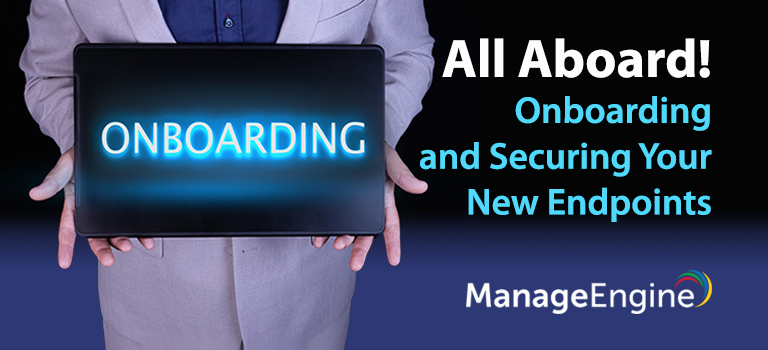Any IT admin worth their salt knows that onboarding new employees or endpoints is not quite as simple as yelling “All aboard!” like a merry captain of a cruise ship. It’s been more than a year since most of us started working remotely, and for many organizations, it looks like this new way of working is here to stay. Complex security threats exist—much like pirates roaming the high seas— putting endpoints and entire organizations at risk, particularly when users work outside the office.
While enforcing security restrictions and protocols is of paramount importance, there are also other tasks that an IT admin must perform for a new user—tasks that differ depending on the user’s role in the organization. Manually performing such tasks is time-consuming, occupies valuable resources, and is not error-proof. Process-driven automation under specific rules and constraints can limit resource wastage and error occurrence. By leveraging the Configurations Module of Desktop Central, IT admins can onboard new users remotely with considerable ease.
A VERITABLE CYBER-CIRCUS
Cybercrime, much like the mean sea level of the oceans, is rising rapidly; buoyed by the large number of endpoints who are now stowed away from the shade of their corporate infrastructure due to the ongoing pandemic and connected to relatively unsafe home networks. As per Cybersecurity Ventures, cybercrime as an industry is set to grow to six trillion dollars; which would make it the third largest economy on its own, behind USA and China. Such numbers, while alarming, are useful indicators for organizations to remain on their toes.
Cybercrime can malign an organization in various ways – from causing business interruptions to monetary losses through reputation damage due to data loss and leakages. As information regarding cybercrime grows along with its incidence, some disturbing trends have become evident. It takes nearly six months on average for a breach to be detected; even if it is a major violation in a giant corporation. The financial setback of each incident is also a major dent; with estimates suggesting that the average cost of a data breach is around 3.9 million dollars across SMBs accompanied with a 7.29% drop in the share price for publicly listed companies. Adding all this to the fact that nearly 95% of cybersecurity breaches are due to human error, and the IT department is seldom the one committing the lapse, it makes absolute sense to ensure that your organization’s employees are educated in safe practices while traversing the internet. To supplement and enforce this, a Unified Endpoint Solution (UEM) with adequate security measures is also pertinent in clamping down upon human error. After all, an entity is only as strong as its weakest link.
Endpoints and the BYOD Trend
One must not forget the prevalence of mobile devices amongst endpoints and increasing BYOD trends. Irrespective of the ongoing health crisis, this trend is rising because an employee using their own device saves a company nearly 350 dollars of revenue per year and provides two extra hours of work on a weekly basis. Personal devices can be nightmarish for IT admins to oversee, being notorious targets for phishing. Managing and securing mobile devices provides a litany of challenges in and of itself. Of course, the well-documented fiscal advantages and increased outputs in productivity amidst the increasing use of personal devices is enough incentive for individuals and organizations to keep employing this course of action for the time to come. Dedicated mobile device management and security features are, therefore, a must for an organization which wishes to be dynamic and versatile in these unprecedented times.
Thus, while a cybercriminal will not differentiate between users or endpoints based on their years spent in an organization, intuitively speaking, newer endpoints including laptops, mobiles, tablets and even flash drives, always remain at higher risk of being ground zero for malicious activities, when taken into an IT environment without implementing appropriate measures from the get-go.
Setting Baseline Configurations as Collections
Desktop Central offers multiple configurations that can be applied to either users or computers across Windows, Mac, and Linux systems. Configurations can be set to start either during system startup or when a user logs in. IT admins can leverage Desktop Central to go one step further and set a group of configurations to be applied during certain instances. A widespread occurrence is the application of a set of configurations that an IT admin requires whenever a new computer is added to their organization. Such configurations can be a combination of measures designed to boost security and productivity.
Desktop Central provides IT admins and technicians with tremendous flexibility to optimize their workflow. Applying individual configurations or collections of them are one aspect of the Desktop Central console. There are a variety of features in Desktop Central to uncover, experiment with, implement and leverage for maximum productivity in a robust and secure environment. Sign up here for a 30-day free trial of Desktop Central.
Sudarshan Kumar
Tags: Cybersecurity, DesktopCentral, Endpoint Security, Endpoints, IT, ManageEngine, Onboarding, UEM


